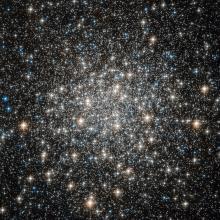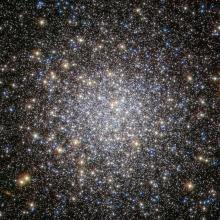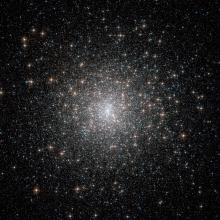Listen to today's episode of StarDate on the web the same day it airs in high-quality streaming audio without any extra ads or announcements. Choose a $8 one-month pass, or listen every day for a year for just $30.
You are here
Messier 5
Our home galaxy, the Milky Way, is about 13 billion years old. We know the age because some of its original stars are still around. Many of them congregate in giant ball-shaped clusters. And one of those clusters is in good view at this time of year.
Messier 5 is in the constellation Serpens, the serpent. As night falls, it’s well to the lower left of Arcturus, a bright yellow-orange star that’s high in the south. Through binoculars, the cluster looks like a fuzzy star. Small telescopes begin to reveal some of its individual stars.
In all, M5 has at least a hundred thousand stars, and perhaps as many as half a million. Most of them are packed into a spherical region that’s about 165 light-years across. For that reason, M5 is known as a globular cluster.
The cluster is about 13 billion years old. Astronomers determined that age by taking a census of its stars. More-massive stars burn out faster than less-massive ones. So finding the heaviest remaining stars in a cluster reveals its age. In this case, the oldest remaining stars are a bit less massive than the Sun, so they’re a bit fainter and oranger.
M5 orbits the center of the galaxy at more than a million miles per hour. That suggests that it comes from the galaxy’s halo — a spherical region that extends far outside the Milky Way’s bright disk. Right now, M5’s orbit has brought it near the disk. Over time, though, it will again loop into the outer reaches of the halo, leaving the disk behind.






